|
Candidate
Team Projects - 2020
Team
Projects are for suitable for three students taking the course for three
credit units.
These projects
will be "pitched" in class on Thursday, January
9th
Project
contacts will be communicated to the project team.
"Recommended
Skillset" is dependent on the selected design concept.
Team Project Titles:
(year originally suggested)
|
Back to top
Projects with
Abby 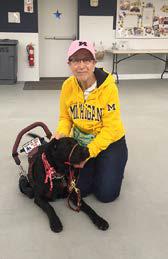
-
Background: Abby is an
artist, a retired art teacher (grades K-College), a clinical social worker, and
a computer graphic designer. She is an individual with multiple disabilities: a
mobility challenge, a bipolar disorder, and a visual impairment. She is
passionate about making a difference and advocating for individual rights. She
has been a chair of the
Consumer
Advisory Council and formerly represented consumers on the Board of
Directors of NAMI (National Alliance on
Mental Illness) in Santa Clara County and has volunteered in their
Connection
Recovery Support Group and the
Peer
PAL Program. She has also volunteered for the
Vista Center for the Blind and Visually
Impaired, has been on the
Board of Directors
of the Silicon Valley Independent Living
Center (SVILC), has successfully been involved in litigation to preserve
the rights of service dog recipients when they are hospitalized, and has
presented Poster Sessions and spoken at conferences including NAMI's National
Convention, California ADA (Americans with Disabilities Act) 2015 Conference
celebrating 25 years and the California Council of the Blind's Annual
Convention. Abby has mentored elementary school students with art lessons, and
partnered with high school students in programs for
Project Invent and
Design the Future. She is
currently updating a therapeutic board game she made for inpatient psychiatric
units. Abby has a successor service dog, Nathan, from
Canine Partners for Life (CPL) in
Cochranville, PA and has served on their Advisory Council.
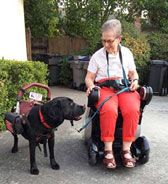 Back to top Back to top
Camping Cot Project
-
Background: "I love
the freedom I feel when I go camping."
-
Problem: "My
Therm-a-Rest camping cot sits low to the ground (6 inches). The bed material
and the long poles across the cot's width are not a problem. However, it takes
a lot of force and hand strength to attach and remove the legs. Even an
able-bodied camper had difficulty putting a leg on, so I didn't use it on a
recent camping trip. It is a great cot, just much too difficult to assemble and
disassemble."
-
"There are 2 collapsible rods
that slide into sleeves down both sides of the cot. The legs are too difficult
to bend into the right position and hook into openings along the sleeves around
the rods. If the legs were integrated into the cot or if there was an easy way
to attach and remove its legs - that would be ideal."
-
"I have tried other cots from
both REI and Sports Basement and have not found one that I could put together
by myself. The Helinox cot is very heavy, and very expensive."
-
"I read a review of Big Agnes
Helinox Cot Lite where it was described as needing a lot of hand strength/force
to put it together - 'note that adult strength is required for assembly and
disassembly'."
-
"Amazon offers many cots, but
unless you actually buy one and try putting it together, you have no idea if it
is in fact light and easy to put together."
-
Aim: Explore designs
for a camping cot that Abby will find to be easy to assemble and disassemble
independently.
-
Design
Criteria:
- "I am interested in a cot
that sits low-to-the-ground."
- Easy to assemble and
disassemble independently
- Lightweight and portable
(parts are collapsible and fit into a small sack)
-
Other:
-
Recommended Skillset:
Mechanical Engineering, Shop
-
Links:
Back to top
Laptray Project
-
Background: "One
project I would like to suggest for your class next year is a tray."
-
Problem: A wheelchair
user's lap is not always an ideal surface as it is not flat, so items may fall
off during travel and the lap may not be at a comfortable height for other
tasks.
-
Aim: Explore designs
for a wheelchair accessory that will aid Abby in performing common tasks.
Anticipated laptray uses include: a drawing / writing / work surface, a support
for a laptop, and a platform for eating.
-
Design
Criteria:
- Fits between arms of
Abby's WHILL wheelchair
- Is lightweight and
portable
- Collapses to fit in Abby's
backpack
- Will not slide off her
lap
-
Other:
-
Recommended Skillset:
Mechanical Engineering, Shop
-
Links:
Back to top
Alert Project
-
Background: "Another
project I am interested in is some kind of an audible alert that I could easily
press to alert people that I am passing. I had this idea for
Project Invent this summer, and the
idea one team was working on was a recording of my voice very loud saying
"Passing By," "Coming Through," or "Excuse Me." My idea is that it would attach
to the right arm of the WHILL so that I would have easy access to press on it.
I have looked at bicycle bells, horns, etc. The problem I have is using both
hands with Nathan and the WHILL, and not being able to hold something else.
Bicycle bells are for rounded handlebars, and don't fit the WHILL arm, plus you
have to turn them, press something small on them, or some other way of getting
the noise that I can't do. The noise has to be loud enough for people to hear
it."
-
Problem: In crowded
spaces, people are not often aware of a wheelchair user trying to negotiate the
"walking traffic", increasing the possibility of collisions.
-
"This is a huge problem
everywhere I go outside in the community, or in buildings. Many times an
individual's attention is not on where they are walking, or how their walking
patterns may affect someone coming from behind in a powered
wheelchair."
-
Aim: Explore designs
to alert people in Abby's path.
-
Design
Criteria:
- Easy access to activation
mechanism on right side of wheelchair
- Easy activation while
operating wheelchair and controlling Nathan
- Loud enough for people to
be alerted in noisy rooms
- Several alert modes and
volumes
-
Other:
-
Recommended Skillset:
Mechanical Engineering, Electronics
-
Links:
Back to top
TravelScoot Camping Project
-
Background: "I go
camping with my TravelScoot. Its
front-mounted
Foldable Shopping Basket is of wire-frame construction and enables me to
hold and transport water bottles and lunches for Nathan and me."
-
Problem: "The basket
does not attach to the scooter very well and it is not very stable."
-
Aim: Explore designs
for an improved device for transporting camping items.
-
Design
Criteria:
- Easy to attach and remove
from the scooter
- Stable when moving around
the camp site
- Foldable for stowing in a
car
-
Other: "I have the
Junior Deluxe model of the TravelScoot. Because it is narrower in the back, it
does not accommodate the company's rear-mounted basket
accessory."
-
Recommended Skillset:
Mechanical Engineering, Shop
-
Links:
Back to top
WHILL Model Ci Enhanced Visibility Project
-
Background: "The WHILL
Model Ci power wheelchair has no lights so it is unable to illuminate my path
for early morning or late afternoon activities such as walking my dog Nathan or
going out at night. This is a real problem when you consider where there are
van accessible parking spaces and locations of activities. A movie and
restaurant outing may include parking in one place, and meeting friends in a
location a block or so away. Lighting is not always available in parking lots,
and many times parking lots are located in back of buildings. Adequate lighting
means the difference between safe maneuvering both for me and Nathan wherever I
want to go."
-
Problem: Abby's new
wheelchair has no lighting which creates a safety hazard while walking Nathan
in the early morning or traveling at night.
-
Aim: Explore ways to
enhance the night time visibility of Abby's wheelchair
-
Design
Criteria:
- Must provide both forward
illumination and side visibility
- Must be easy to attach and
remove
-
Other:
-
Recommended Skillset:
Mechanical Engineering, Electronics
-
Links:
|
|
Back to top
Projects with
June 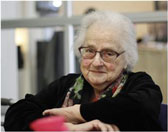
-
Background: June
Fisher is a Senior Scientist at the Trauma
Foundation, "Chief Elder Officer" for Aging2.0 (a global network of innovators in
aging), designer, and a frequent lecturer in Stanford's Department of
Mechanical Engineering. She formerly was an Occupational Health Physician,
Associate Clinical Professor of Medicine at the University of California at San
Francisco. June uses a rollator for balance and stability when moving around
her San Francisco home.
Back to top
Clean House Project
-
Problem: June's use of
her rollator makes it difficult for her to perform home cleaning tasks
independently.
-
Aim: Explore designs
to provide a safe, effective, and independent means of performing common
household cleaning tasks.
-
Design Criteria: The
solution must be safe to use, easy to operate, and be compact to
store.
-
Other: Visits to
June's home in San Francisco will be required.
-
Recommended Skillset:
Mechanical Engineering, Shop
-
Links:
Back to top
Within Reach Project
-
Problem: June
increasingly finds that items in her upper kitchen and closet shelves are now
out of her reach. Currently available step stool solutions do not meet her
needs: some are too tall, others have a stepping area that is too small, and
most do not have hand-holds to provide needed balance and stability during
reaching. Finally many step stools are heavy and bulky, making them difficult
to move and position.
-
Aim: Explore designs
to provide a safe and stable means of accessing items on upper
shelves.
-
Design
Criteria:
The solution must:
- integrate onto her
walker
- be easily installed onto
and removed from her walker
- be able to be fitted to a
variety of walker products
- be easily deployed for
stepping and retracted when not being used
The stepping area must:
- offer a sense of security
during use
- have a wide, non-slip
surface
- provide the proper height
advantage
-
Other: Visits to
June's home in San Francisco will be required. June has an extra walker to
donate to this project.
-
Recommended Skillset:
Mechanical Engineering, Shop
-
Links:
|
|
Back to top
Project with
Paul 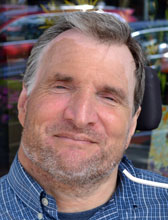
Access to Photography
-
Background: Paul is an
active resident of Redwood City who uses a powered wheelchair. He recently
participated in the Design the Future program at Stanford where he coached high
school students on assistive technology projects that addressed some of his
challenges. Paul's quadriplegia left him with very little movement and strength
in his left arm.
-
Problem: Paul is
interested in photography, but his limited hand grip and arm range of motion
make it challenging to hold a camera, aim and focus on a subject, and take the
picture.
-
Aim: Explore solutions
that would enable Paul to enjoy photography.
-
Design Criteria: The
design should be easy to deploy and stow away, aim, and take photos
-
Other:
-
Recommended Skillset:
Mechanical Engineering, Shop
-
Links:
|
|
Magical Bridge Playground
-
Background: The
Magical Bridge Playground is the nation's first fully accessible and socially
inclusive playground. It is a public space where children with disabilities as
well as children of parents who have a disability can play together. The City
of Palo Alto designated 1.3 acres of underutilized public land in Mitchell
Park, located at
600
East Meadow Drive in Palo Alto, for the site of the Magical Bridge
Playground - adjacent to Abilities United and close to the new Mitchell Park
Library.
-
The
playground
opened in April 2015 and has been overwhelmingly popular with both kids and
parents, with some families traveling long distances to experience
it.
-
After the Playground was
completed, the Magical Bridge
Foundation was created to assist other communities in building their own
innovative and inclusive playgrounds. Construction on a Playground in Redwood
City began in the Fall of 2017, and funds are currently being raised for
Magical Bridge Playgrounds in Sunnyvale and Morgan Hill.
Back to top
Project with Olenka at
the Magical Bridge Playground 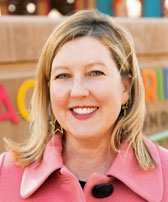
Accessible and Inclusive Playground Attractions
-
-
Problem: The
park's play equipment has been well-received, but some aspects of the play
areas could be modified for better access. In addition, suggestions for
replacement play areas are sought to update the park with fresh attractions
every few years. And as new Playgrounds are planned and constructed, there are
ongoing opportunities to design new features and refine existing designs to be
accessible to everyone regardless of their abilities.
-
Aim: Explore
designs to improve access to and navigation around the playground, as well as
to create new play and educational experiences incorporating multiple senses,
actions, and outcomes for all playground users and visitors, especially those
with visual impairments and diminished fine motor skills.
-
Design
Criteria:
- Designs should be
durable, fun, and safe for everyone - accommodating children and parents with
disabilities - and be magical.
- Project prototypes
could be scale models to facilitate their construction and
transportation.
- Designs that
incorporate electronics should be low-voltage or solar-powered.
-
Recommended
Skillset: Mechanical Engineering, Mechatronics, depends on selected design
concept
-
Links:
|
|
Back to top
Projects with Danny and
Stanford 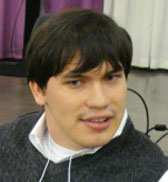
-
Background: Danny is a
wheelchair user who lives in Los Gatos with cerebral palsy and a cortical
vision impairment.
Back to top
Wheelchair Position & Transfer Project
-
Problem: Due to
Danny's limited upper body strength and grip impairment, he experiences
difficulties positioning himself in his wheelchair and assisting his caregiver
when he is being transferred into and out of his wheelchairs.
-
Aim: Explore design
solutions that would allow Danny to position himself in his wheelchairs
independently and to better assist his caregiver during wheelchair
transfers.
-
Other:
-
Recommended Skillset:
Mechanical Enginnering, Shop
Back to top
Wheelchair Restraint Project
-
Problem: Due to
Danny's vision and grip impairments, he experiences difficulties securing the
"seat belt" safety restraint system on his current wheelchairs.
-
Aim: Explore design
solutions that would make it easier for Danny to buckle himself into his
wheelchairs independently.
-
Other:
-
Recommended Skillset:
Mechanical Enginnering, Shop
-
Links:
|
|
Back to top
Projects with
Amy 
Wheelchair Dancing
-
Background: There is
considerable medical support documenting the positive health benefits of dance
and movement for people experiencing stress-related physical and psychological
symptoms, pain, depression, cardiovascular disease, dementia, Parkinson's
disease, diabetes, cancer, and other conditions - promoting emotional, social,
cognitive, and physical well-being, as well as an enhanced quality of life.
Movement / Dance classes are offered at many Senior Centers.
-
Problem: Individuals
who use wheelchair are unable to "dance" in the traditional sense and some
older adults who don't use wheelchairs may experience balance issues that may
affect their ability to stand, walk, or move safely. However, with
encouragement, they can all engage in dance while seated through movement of
the body parts they can control: head, neck, arms, hands, torso, and
feet.
-
Aim: Explore designs
to provide encouragement and enhance the dance experience for both wheelchair
users and individuals who can not stand for long periods.
-
Design Criteria:
- the design should not
permanently alter the user's chair or wheelchair
- the design should be
portable
- the design may be
battery-powered
- the design may provide
encouragement and attention in multiple ways
-
Other:
-
Recommended Skillset:
Mechatronics, Mechanical Engineering, Shop
- Links:
Organizations:
Medical Conditions:
Cancer
Dementia
Cardiavascular
Disease
Arthritis
Older
Adults
Chair and Wheelchair Dancing:
Back to top
Creative Expression using an Instrumented
Wheelchair
-
Background: Most
everyone has a desire to be creative through activities such as writing,
painting, sculpture, pottery, jewelry, quilting, photography, singing, dancing,
and music.
-
Problem: Existing
tools supporting creativity are often lacking for people with disabilities.
Movement difficulties may prevent an individual from fully participating in
their chosen activity.
-
Aim: Explore ways to
enhance creative expression for people with disabilities, especially those who
use wheelchairs. This could include the creation of new activities or
fabrication of new tools.
-
Design
Criteria:
- The design should express
the user's creative nature as a visible or audible output
- The design should not
permanently alter the user's chair or wheelchair
- The design should be
portable
- The design should be
battery-powered
-
Suggestions:
- Convert the user's
existing assistive technology device (such as their wheelchair) into a creative
"paintbrush" or "musical instrument" or "light show"
- Use non-traditional inputs
such as the user's residual movements or wheelchair motion
-
Other:
-
Recommended Skillset:
Various, depends on chosen solution
-
Links:
|
|
Back to top
Projects with
Nick 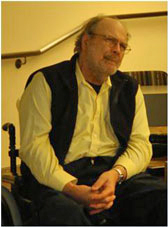
-
Background: Nick is an
experienced manual wheelchair rider. In addition to propelling his wheelchair,
he performs occasional "push-ups" to relieve pressure on his buttocks to
prevent pressure sores.
Back to top
Arm Rest Project
-
Problem:
- Nick reports several
problems with the stock Dual Post Height Adjustable "Removable" Arm Rests on
his Quickie Model GP wheelchair:
- They are too short from
front to back, interfering with the placement and operation of the wheel
locks.
- They are too tall,
preventing his shoulders from resting in a natural position.
- They are too heavy, due to
height adjustment hardware.
- They interfere with safe
transfers in and out of wheelchair.
-
Aim: Explore Arm Rest
designs that address these problems.
-
Design Criteria: The
Arm Rest design must:
- Be strong enough to allow
pressure reliefs without deforming
- Enable Nick to more easily
reach and operate the wheel locks
- Retain the "clothes guard"
feature
- Improve transfer
safety
-
Other:
-
Recommended Skillset:
Mechanical Engineering, Shop
-
Links:
Back to top
Improved Wheelchair Caster Wheel
Project
-
Background: Nick is an
active older adult who uses a manual wheelchair for his
mobility.
-
Problem: During
direction changes, existing caster wheels on manual wheelchairs require space
to pivot around and increase propulsion effort.
-
Aim: Explore
non-castering omni-wheels as a caster wheel replacement.
-
Design Criteria: The
design must:
- Be a plug-in replacement
for the existing caster wheels
- Be durable and strong
enough to support the rider
- Require measurably less
effort to propel the wheelchair
-
Other:
-
Recommended Skillset:
Mechanical Engineering, Shop
-
Links:
|
|
Back to top
Project with Nathan and
Zia 
Wheelchair Accessories Project
-
Background: "My son,
Nathan, is very sharp mentally despite being very limited physically due to
quadriplegia and spastic cerebral palsy. He lives independently in Hayward
where he receives 24 hours a day 7 days a week caregiver support." -
Zia
His power wheelchair has a
light to illuminate his path at night, a mirror that provides rearward
visibility, a storage pouch for his medicine and grooming products, a fixture
to hold his cellphone, a power conversion product that charges the cellphone
from his wheelchair battery, and a bag behind his chair that holds his water
bottle.
-
Problems:
- Nathan's chair does not
have a laptray.
- The forward lighting is
insufficient to illuminate his path adequately.
- Nathan has a difficult
time accessing the light switch due to his limited hand mobility.
- The mirror does not
provide rearward visibility when it bumped out of its correct
position.
- The mirror mechanism makes
transferring to and from his bed and wheelchair difficult due to its shape and
location.
- The lack of a cup holder
makes drinking a challenge. Currently water is supplied from a bottle stored in
the bag behind the wheelchair using straws.
- There is no charging ports
or storage area for Nathan's laptop, notepad, or digital book
reader.
- There is no emergency
alert mechanism.
-
Aim: Explore designs
to address the problems that Nathan experiences with his
wheelchair.
-
Design Criteria: The
solutions must:
- not interfere with power
wheelchair functions
- be lightweight, durable,
waterproof, and be able to be detached easily from the wheelchair
- include several battery
charging USB ports
-
Other:
-
Recommended Skillset:
Mechanical Engineering, Shop
-
Links:
|
|
Back to top
Project with
Ben 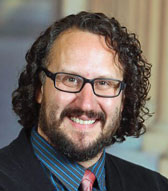
Laptray for Ben
-
Background: Ben has a
new self-balancing power wheelchair from Omeo Technology (New Zealand). On the
left side of the wheelchair is a "multi-functional holder for accessories", a
StarPort I Marine
accessory mount made by Railblaza.
-
Problem: Ben's
wheelchair positions him higher than if he were sitting in a chair at a table,
making working or eating difficult. Omeo Technology does not offer a laptray
accessory to put items such as a tablet, laptop computer, and food
tray.
-
Aim: Explore designs
for a custom laptray for Ben.
-
Design Criteria: The
design must be:
- removable, can be stored
on the wheelchair when not used
- minimalistic
- aesthetically
pleasing
- functional
- accommodate the
front-to-back rocking motion when the chair is balancing.
-
Other:
-
Recommended Skillset:
Mechanical Engineering, Shop
-
Links:
Videos:
|
|
Back to top
Project with
Jerry 
Smartphone and Tablet Holder for Easy Viewing and
Stability
-
Background: Jerry
resides in Sunnyvale and rides a bike or uses public transportation to get
around. He has dexterity issues with both his hands.
-
Problem: Jerry
experiences challenges holding his smartphone or tablet when seated. Placing
the device on his lap does not provide a secure platform and often results in
the device falling. Setting it flat on a table or desk does not offer a good
viewing angle.
-
Aim: Explore designs
that would provide a secure and stable platform for Jerry to view his tablet or
smartphone display.
-
Design Criteria:
- Easy connect / disconnect
mechanism for the tablet or smartphone
- Adjustable viewing
angle
- Securely and stably hold
the tablet or smartphone
- Easy to use by individuals
like Jerry who have limited hand dexterity and strength
-
Other:
-
Recommended Skillset:
Mechanical Engineering, Shop
-
Links:
|
|
Back to top
Project with
New Project
-
Background:
-
Problem:
-
Aim:
-
Design Criteria:
-
Other:
-
Recommended Skillset:
-
Links:
|
|
Back to top
Projects Suggested by
Dave:
Creative Expression
-
Background: Most
everyone has a desire to be creative through activities such as writing,
painting, sculpture, pottery, jewelry, quilting, photography, singing, dancing,
and music.
-
Problem: Existing
tools supporting creativity are often lacking for people with disabilities.
Movement difficulties may prevent an individual from fully participating in
their chosen activity.
-
Aim: Explore ways to
enhance creative expression for people with disabilities. This could include
the creation of new activities or fabrication of new tools.
-
Suggestions:
- Convert the user's
existing assistive technology device into a creative "paintbrush" or "musical
instrument"
- Use non-traditional inputs
such as residual movements or brain waves
- Adapt or create
instruments for musicians with disabilities
- One-Handed Musical
Instrument (OHMI) Competition
-
Other:
-
Recommended Skillset:
Various, depends on chosen solution
-
Links:
Back to top
Designing Your Afterlife
-
Background: Death is
the most severe form of disability as one is no longer able to interact with
people or physical objects in the living world. What remains are only frozen
static artifacts - images, writings, and the stories of others. Gone are one's
personality, beliefs, expertise, humor, vision, memories, insights, and
intellect.
-
Problem: With one's
passing, it is impossible to provide a full and accurate representation of whom
they were, what they believed in, and how they acted. The recollections of
family and friends fade and disappear with time, leaving the departed one's
legacy at the mercy of the living.
-
Aim: Explore ways to
preserve one's essence after death. In the technology extreme, this might
manifest itself as an interactive system that responds to queries, retells
stories, relates experiences, shares expertise, and expresses humor. The
pre-dead user would be able to create and program his / her eternal
computer-based persona before her / his demise.
-
Other:
-
Recommended Skillset:
Various, depends on chosen solution
-
Links:
|
|
Back to top
Student-defined Team Projects
- Meet
with course instructor to discuss and agree upon the specifics of the project.
Interview, observe, and discuss assistive technology problems with an
individual with a disability or older adult. Address their desire to
participate in one of the following activities by designing an adaptation to an
existing device / tool or creating a new, more useful one. Projects could
address:
-
-
Activities of Daily
Living - cooking, showering or bathing, dressing, cleaning, housework, yard
work, employment, education, shopping, commuting, etc
-
Sports and
Exercise - walking, running, indoor and outdoor sports, etc
-
Leisure Activities and
Hobbies - collecting, model making, crafts, board games & videogames,
etc
|
|
Back to top
Other project
ideas
- Project Coach:
- David L. Jaffe,
MS
|
Back to
top |